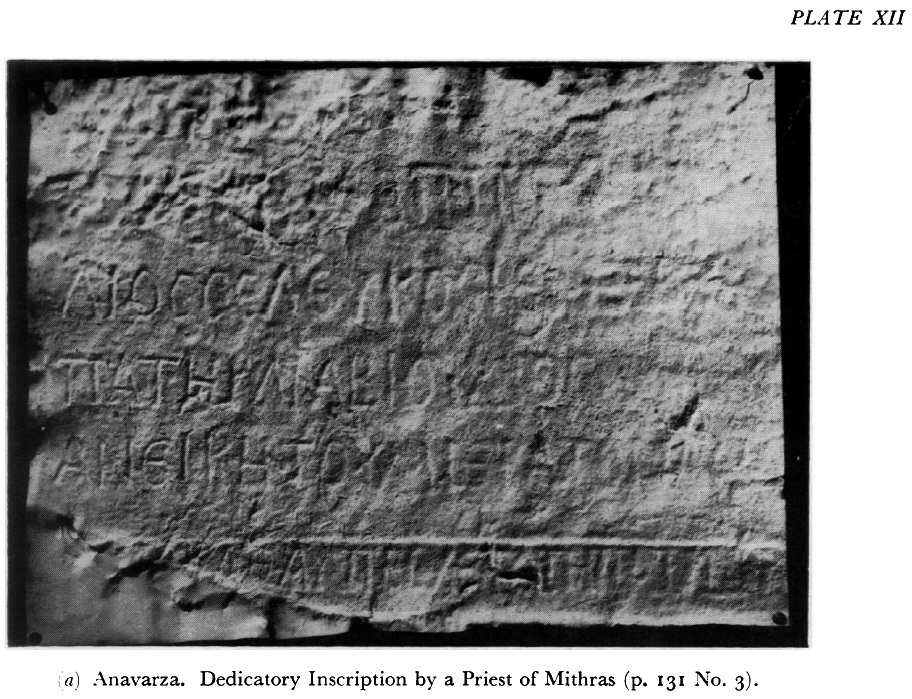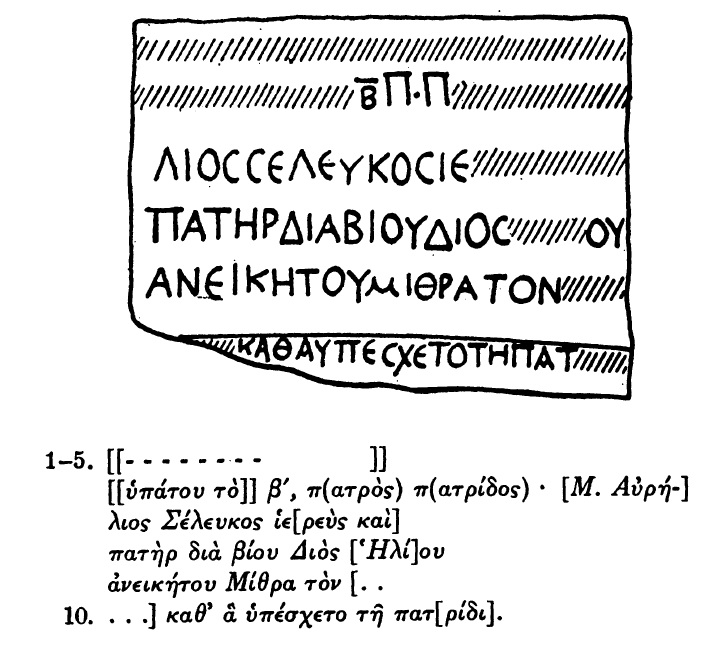
CIMRM 27bis - Inscribed altar. Anazarbus, Cilica.
During the summer of 1950 a small limestone altar was found at the south-west end of the stadium at the site of Anabarzos in Cilicia. On one side was an inscription in Greek. The first 5 lines had been erased with a chisel, while the remaining 5 lines were badly weathered. The inscription was by a certain M. Aurelius Seleucus, priest of Mithra. The opening section seems to have been dedicated to an emperor who since suffered damnatio memoriae. The lettering is perhaps 3rd c. A.D.1
From Michael Gough, Anazarbus, Anatolian Studies, Vol. 2 (1952), pp. 85-150.
3. Ibid. At south-west end of stadium. Bomos with projecting mouldings at top and bottom. H. 1.37 ; w. 0.47 ; th. 0.45 ; letters. 0.04-0.025. Smaller letters in last line only. Apart from the almost total erasure of the first 6 lines, the inscription is very badly worn. (See Pl.XIIa). L.I /5 are totally erased in conformity with the damnatio memoriae of the Emperor whose name originally appeared on the stone. I have restored M. Au)rh- at the end of L.6. Seleucus, to judge from the office which he held, must have been a man of some eminence. As path/r shows in L.8 he belonged to the seventh and highest grade of Mithraic initiates. Plutarch, (Vita Pompeii, XXIV), writing of the Cilician pirates, states ... . It is interesting, therefore, that of the very rare relics of Mithraism in Asia Minor two should have a Cilician origin. The first is the inscription published here, while the other is a coin of Tarsus with the head of Gordian III on the obverse, and the effigy of the god on the reverse.
Such is the paucity of evidence of Mithraism in Asia Minor that the statuette of an initiate with the rank of leo purchased by the late Sir William Ramsay at Konya, and published by him in his Revolution in Constantinople and Turkey, p. 214 ff., 306 ff., would be of great importance if genuine. Unfortunately it is almost certainly a modern forgery. Not only is it a clumsy and unconvincing piece of work, but the story of its antecedents published by W. M. Calder, "Missak LATUPOJ?", JHS, XLVII, 1927, pp. 178/179, makes it virtually certain that the statuette is a fake. Professor Calder, referring to the "coating of fine dust" covering the statuette at the time that Sir William bought it, mentions that in 1912 while scrubbing a small relief for an impression "a light brown substance with which it was coloured washed off, disclosing a white, sparkling marble, which looked as if it had been freshly carved", and that this convinced him that the relief was a forgery, since he had never known the natural discoloration of marble to disappear in this way. It may be of interest, therefore, that when in 1950 in Cilicia I was shown a collection of appallingly bad statuettes which were certainly forgeries, all of them were coated with the " light brown substance " described by Professor Calder.
From "Handbuch Der Orientalistik: Nahe und der Mittlere Osten, Volume 3; Volume 53", edited by John O. Hunwick etc., p.306:
The coin types of Tarsus then have, however, nothing Iranian about them, but bear among other devices a seated Tyche with the river Cydnus at her feet, and Sandan, the ancient Hittite god.6 These types continued into Roman imperial times, and were joined then by most of the divinities of the Greek pantheon; and, unusually, on a coin of the time of Gordian III (238-24-1), Mithras appears sacrificing the bull.[237] Other traces survive in Level Cilicia of the Mithraic Mysteries, brought there presumably by the Romans;[238] but the only indications of the presence of Zoroastrians are provided by a Christian bishop, Theodore.239 He was born in Antioch about 350, and grew up there, becoming the most eminent representative of the Antiochene school of theology. He began to write against those holding other Christian views in about 383, and a decade or so later was made bishop of Mopsuestia in Level Cilicia. He was a prolific author, producing, as well as commentaries, extensive dogmatic and polemical works; and among the latter was a book in three volumes on Persian magism (Peri tes en Persidi magikes), and how this differed (greatly naturally to its disadvantage) from Christianity. This book is known only from the briefest of summaries by Photius,.... 237. Excavations at Anazarbus (one of only 2 cities of note on the upper plain of Level Cilicia, dexeloped as a strategic point by the Romans) have yielded an altar dedicated by M Aurelios Seleukos "priest and pater for life of the Sun-God, the uncontested Mithras"; published by M. Gough. AS II. 1952. 131 no 3 with Pl. XIIa; Vermaseren, CIMRM. II p. 13 no. 27 bis.
From Roger Beck, "Mithraism since Franz Cumont", ANRW 2, p.2019:
... 27bis (Supplement), a dedication by one M. Aurelius Seleucus i9ereu\j kai\ path\r dia\ bi/ou Dio\j H(li/ou a0neikh/tou Mi/qra at Anazarbus in Cilicia (unlike most Mithraic inscriptions, displayed in a public place).
CIMRM entry
28. During the Congress of Ancient Anatolian Studies in Istanbul 1952 M. Gough lectured about "a new Mithraic inscription from Anazarba". The monument has not yet been published.
External links
- M. Gough, "A new Mithraic inscription from Anabarzos", Proceedings of the Twenty-second Congress of Orientalists, Brill, 1957, p.99: "...at the end of the fifth line. ... These letters almost certainly represent the end of a Roman imperial title ... The lettering of the inscription (admittedly not a very reliable criterion of date) appears, on comparison with other inscriptions from Anabarzos, to belong to the 3rd century A.D."
- Mary Boyce, A history of Zoroastrianism, vol. 3, 1975. In: Handbuch der Orientalistik: Der Nahe und der Mittlere Osten, Part 1, p.306, translating as "priest and pater for life of the Sun-god, the uncontested Mithras". Vermaseren in Mithras the Secret God translates here as "Zeus-Helios-Mithra".
| 1 | M. Gough, "A new Mithraic inscription from Anabarzos", Proceedings of the Twenty-second Congress of Orientalists, Brill, 1957, p.99. |
| Tweet |

